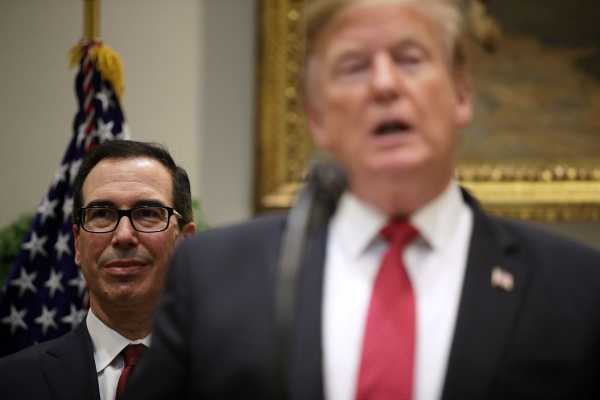
On March 1, the federal government is scheduled to hit the debt ceiling, running out of legal authority to borrow money — a potentially crippling problem because trillion-dollar deficits require regular bond sales to keep money flowing.
The date isn’t a hard deadline in financial terms because the Treasury Department has a range of tactics (known as “extraordinary measures” to veterans of earlier iterations of this fight) to keep the lights on for a while once the debt ceiling is breached. But extraordinary measures can only last so long, and without congressional agreement, the Treasury would eventually be plunged into an unprecedented form of legal and economic chaos.
These standoffs weren’t a big deal during President Donald Trump’s first two years in office, when Republicans suddenly forgot their Obama-era objections to government borrowing and Democrats were disinclined to pick an irresponsible fight.
But difficult standoffs over the debt ceiling were a regular feature of much of the Obama years. And with Democrats now running the House and the party in a certain degree of internal turmoil, some in the White House are worried that debt ceiling brinksmanship might make a comeback — and so far nobody on the Democratic side is saying much one way or the other.
A very brief history of the debt ceiling
Once upon a time, whenever the federal government borrowed money, the bond issuance was specifically authorized by an act of Congress. But during World War I, American leaders decided this was too cumbersome and instituted a new policy whereby Congress would simply authorize such-and-such an amount of borrowing and the Treasury would work out the details. Because this statutory debt ceiling wasn’t adjusted for inflation, economic growth, or the size of the population, it needed to be raised from time to time. In the era of the gold standard, deficits were normally low and it wasn’t a big deal.
But after Richard Nixon ended the convertibility of the dollar to gold — and especially after Ronald Reagan’s tax cuts blew up an unprecedented peacetime deficit — the debt ceiling became a kind of silly political football.
Congress establishes mandatory spending on programs like Social Security, Medicare, and Medicaid through the legislative process. There is, separately, an annual (or annual-ish) appropriations process by which Congress decides how much money the Pentagon and other discretionary agencies should spend in any given year. And separately from that, Congress every so often changes the tax code — which, combined with the ups and downs of economic life, determines how much money comes in.
The Treasury then sells bonds to make up the difference. But the selling of bonds does not, itself, allow for any extra spending beyond what’s been authorized by law. All it does is prevent the federal government from reaching a calamitous situation in which it cannot pay bills that it is legally obligated to pay — including bills that it owes to buyers of previous rounds of federal debt issuance.
Not raising the ceiling would be insane. But the need to raise it has traditionally offered opposition members of Congress an opportunity to do some grandstanding.
Back in 2006, first-term Sen. Barack Obama voted “no” on a debt ceiling increase. He didn’t actually attempt to argue that breaching the ceiling would be a good idea, he just voted no and then complained that “the fact that we are here today to debate raising America’s debt limit is a sign of leadership failure.”
A few years later, when Obama was president and Republicans seized a majority in the House, the GOP flipped this logic around and demanded genuine policy concessions — eventually taking the form of the spending cuts known as sequestration — in exchange for raising the ceiling.
Brinksmanship didn’t work out well for anyone
The Obama administration initially welcomed the idea of using the need for a 2011 debt ceiling increase to force a negotiation over the long-term future of the national debt. His idea was to strike a deal whereby Democrats would agree to cuts in Social Security (most likely by changing the inflation index used to calculate cost of living adjustments) and Medicare (most likely by raising the retirement age) and Republicans, in exchange, would agree to higher taxes on the rich. Given that tax cuts enacted by George W. Bush were scheduled to expire at the end of 2012 anyway, this was a very generous offer from the White House.
But conservatives in the House turned it down, pushing party leaders to demand an all-cuts approach to deficit reduction.
The result was “sequestration” and the Budget Control Act, which mandated sharp cuts in discretionary spending equally split between military and nonmilitary programs. This accomplished the reverse of a barbell stimulus — hurting the economy with short-term austerity while doing nothing to alleviate the long-term issues.
After that unpleasant experience, debt ceiling wars began to wane. The furthest-right members of the GOP caucus continued to push for fights, but the ceiling was repeatedly “suspended” or raised through deals in which Democrats delivered most of the votes, but GOP leadership ensured enough Republican votes for the deals to pass. With Trump in the White House, there was a brief flurry of interest from the hard-right in using Republicans’ newfound political power to leverage the ceiling into spending cuts but the party swiftly pivoted to an agenda of giant tax cuts, large increases in military and security spending, and moderate increases in domestic spending instead.
Democrats implemented half a solution
Many veterans of the Obama-era debt ceiling wars came around to the conclusion that the statutory debt ceiling should simply be abolished. Congress, after all, controls the levels of taxation and spending and thus directly control the amount of borrowing that happens. Requiring separate votes to authorize the debt carries large risks and accomplishes nothing policy-wise.
Practically minded members of Congress, however, are wary of the idea of casting a vote that could be characterized as an embrace of unlimited government debt.
So upon taking the majority, House Democrats instead went back to an older trick from Bill Clinton’s administration and reimplemented something called the Gephardt Rule (named after former House Democratic leader Dick Gephardt) as part of the overall rules package governing the House.
The way the Gephardt Rule works is that any time the House passes a budget resolution, it is also “deemed” to have increased the debt ceiling to the appropriate level needed to execute the budget. This eliminates the need to have a specific vote on the debt ceiling and thus allegedly spares members the political cost of having voted specifically in favor of authorizing more debt.
Does this distinction between passing something and merely deeming it passed actually mean anything to voters? I, personally, am skeptical, but veterans of the “deem and pass” maneuver House Democrats used back in 2010 to implement a version of the Affordable Care Act that contained some provisions they disagreed with will recall that veteran House Democrats have an almost religious faith in the political power of procedural arcana.
Regardless of the merits of the deem move, when Democrats implemented this at the beginning of the year it was initially hailed as a useful way to defuse the debt ceiling issue. In practice, however, it does nothing at all for 2019, because there is no budget resolution and House Democrats and Senate Republicans haven’t even made a vague gesture of trying to negotiate one.
So the same basic issue is back.
The Treasury is going to need to ask Congress to authorize more borrowing, and members of Congress — especially Democratic Party members who voted against the tax cuts that have done so much to make the borrowing necessary — are going to feel churlish about doing it.
Nobody knows what the plan is
The formal arrival of the debt ceiling is less than two weeks away, but stakeholders on Capitol Hill and the executive branch do not yet seem to be zeroing in on the issue in any clear way.
Over the weekend, Axios reported that the issue came up briefly before a recent Cabinet meeting, with the substance of the conversation being optimism from Treasury Secretary Steven Mnuchin that Democrats would pass a clean debt ceiling increase and cautionary words from Mulvaney that you shouldn’t count on House members to be consistent.
Actual House Democrats, meanwhile, give no indication whatsoever that they are planning to pick a fight over this. But they also don’t have any immediate plans to move on a debt ceiling increase. Instead, they are counting on outside analysis from groups like the Bipartisan Policy Center, who say that Treasury’s extraordinary measures can keep the government adequately liquid until some time over the summer.
Neither financial markets nor the Treasury Department love the idea of acting totally nonchalant about this until the last minute, but even Democrats who don’t want to pick a fight over breaching the debt ceiling probably won’t lose sleep over the prospect of some transient stock market turmoil.
The administration itself hasn’t yet come to the table with a formal request to raise the debt ceiling, and OMB is prepping some kind of plan to use the budget sequester to try to force House Democrats into cutting domestic spending. Democrats are reluctant to try to weaponize the debt ceiling but aren’t going to want to give in to Republican demands on spending levels, either. Consequently, there will likely be a push from some Democrats to resolve the two issues simultaneously, an idea neither the White House nor congressional Republicans yet seem to have fully considered.
Sourse: vox.com






